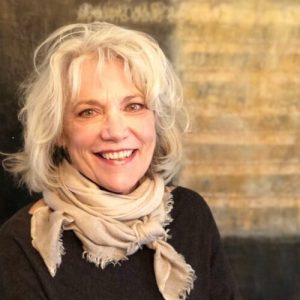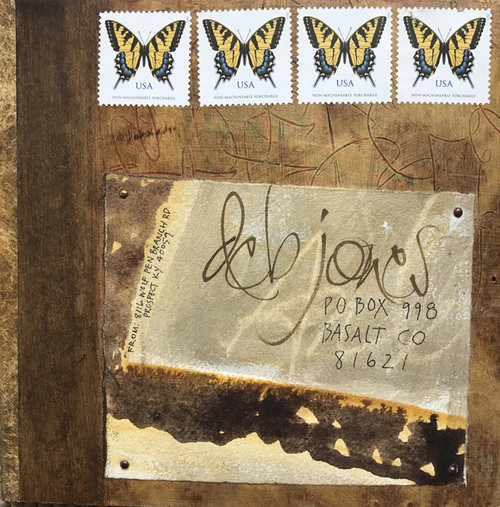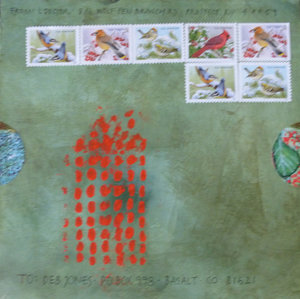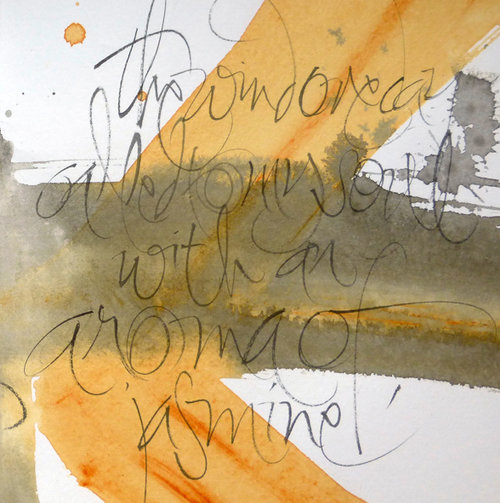Interview with Laurie Doctor
conducted by Dave Mehler
TCR: Laurie, on the home page for your website before you enter is your name, and under that, titles: Painter, Calligrapher, Teacher, & Writer. How do you juggle each of those callings and how do they interact with one another for you?
I have a mind that wants to integrate ideas, have them be part of a whole — so, I sometimes have difficulty separating them. For example, if I am teaching a class in painting, it will include warm-up exercises with writing. I find that students —beginning and advanced, calligraphers and non-calligraphers — express an interest in writing. By this I mean both poetry and the visual aspect of learning an alphabet. Having said this, I will attempt to talk about each one:
Drawing / Painting:
I have many sketchbooks, and love to draw, especially what I see in the natural world. When I look at the object long enough, I begin to see. Drawing becomes a visceral, pleasurable felt thing — so that even if the object is far away, it is as if I am touching it. When I leave my sketchbook, and go to canvas to paint, my gaze shifts inward. I am more compelled by what I cannot see, and lose the interest I have when drawing, of being representational. This approach feels more difficult, as my only reference point is something I am searching for. It often takes a long time for me to “find” a painting. I don’t have the benefit of knowing where to begin, by studying what is in front of me. What I am trying to say is said so beautifully by the poet, A. R. Ammons, in his poem,
Poetics:
not so much looking for the shape
as being available
to any shape that may be
summoning itself
through me
from the self not mine but ours.
My background is in literature, poetry, mythology, and psychology. My painting is deeply influenced by these studies, and by my dreams. I had the honor of working with the poet, Galway Kinnell, and his poem, Another Night in the Ruins. All he asked for in return was images. The exhibit became an ekphrasis event with poets and musicians performing at the opening in response to a specific painting. My next exhibit is something different than I usually to — it is called “constructions.” Martin Erspamer and I are collaborating, and creating pieces from driftwood, bits of metal, earrings, wire and canvas. I don’t know where this is going, but Martin and I have such joy in creating, and play that the freedom from having a specific goal or image creates.
Calligraphy
Calligraphy perhaps first needs to be defined: it comes from the Greek meaning “beautiful writing”. I did not even know calligraphy existed until after graduate studies in education — but as a child I spent countless hours making pages of letters on lined paper we were given in grammar school. I kept journals from the age of 10, making up “codes” so that my mother couldn’t read what I had written. This is probably the root of my studies of ancient texts, and designing alphabets. I began this long before “asemic” writing became a trend (and trends are always in danger of becoming trite). It takes knowledge, and the ability to see one develops from drawing, to make an alphabet where the letters belong to each other. If I use text in a painting, my intention here is to use it only if it belongs in the painting, becoming part of its fabric. My impulse here too, is to not be literal or representational (legible writing has its place in sketchbooks, commissions, etc.). I don’t want to dictate meaning for my paintings. I want to leave room for the imagination of the viewer, who has her own exchange with the painting, making her own connection.
Teaching
My teaching incorporates aspects of painting, calligraphy and poetry. I am not sure how many poems I have memorized, but it gives me great pleasure to do this, and takes me deeper into the poem. Poetry is part of every class. My burning desire in teaching is to provide an atmosphere that brings out each student’s best work. The classroom has a contemplative atmosphere and periods of working in silence. I have had the privilege of teaching in beautiful places all over the world. Teaching is a natural balance to the solitary work of painting and writing. I learn so much from the students, and also the places I get to see. Since we are in the midst of COVID-19, my direction for teaching is uncertain. Like every one else, I am exploring possibilities and hoping that the places we have scheduled for retreats will be open in 2021. My focus during this sequestered time is on writing a book of essays and images that integrate calligraphy, painting and teaching.
TCR: Your mentioning collaborating with Martin Erspamer, reminds me that you mentioned on your blog collaborating with him before with these masks:
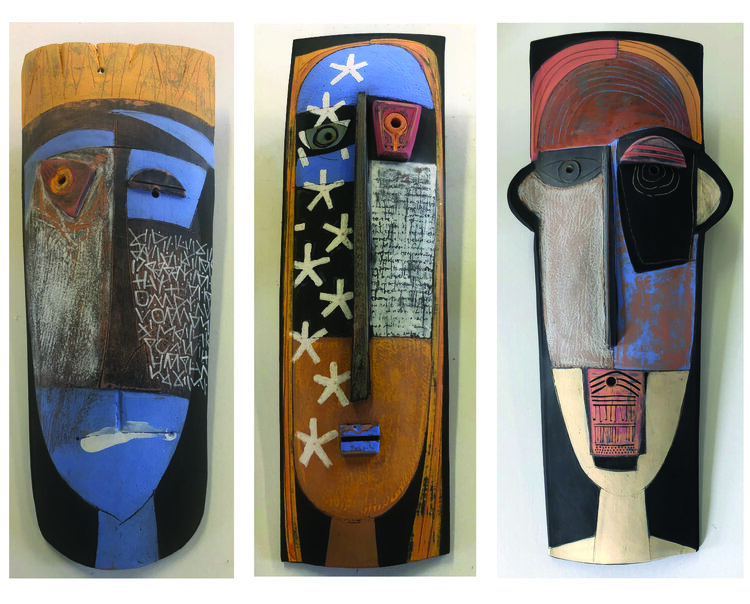
Yes, this was also with Martin Erspamer. To collaborate with someone who has skill, and knows how to play, makes something wonderful and unexpected happen.
And I also noticed too a post regarding a workshop in which you did correspondence art with “Deb?”
Yes, Deb Jones is another artist in Colorado.
And Galway Kinnell?!
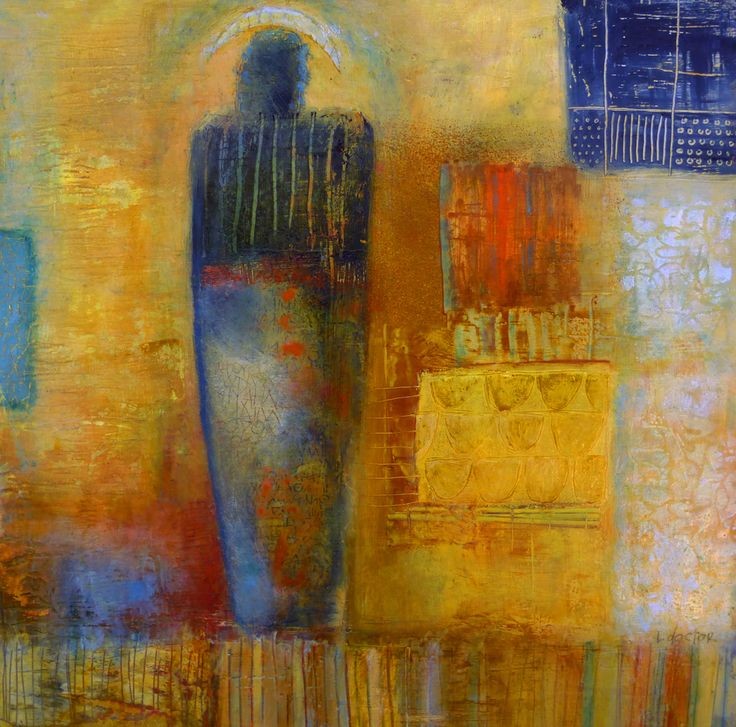 Laurie Doctor, The Nameless Things, Oil on Wood, 12″ X 12″
Laurie Doctor, The Nameless Things, Oil on Wood, 12″ X 12″
This is “The Nameless Things” 12” x 12” oil on wood.
Below is another from that series: “In the Evening”. For this exhibit I had the opportunity to work with Galway Kinnell. He gave me permission to use his poem “Another Night in the Ruins” as inspiration for this work, and
asked to have images in return. I have a couple letters from him that I treasure, as I had no idea at the time that he was ill.
TCR: My wife, Sally, is your cousin. She told me to bring up and ask you about a life-changing moment for you when you were driving on a mountain road (in Colorado?) and your car left it to land and become suspended in a tree? Can you share more and elaborate on this?
Laurie answered this question by sending along the essay we published (just a page or two back) in this issue here: Fishing the River
TCR: What would you say most charges and drives your creativity at the moment—do you have any habits or rituals that help?
Ritual / Structure
I learned early on, as a single self-employed mother of two young children, that a structure for the day is essential — for focus and manifestation. The structure changes, depending on what my focus is, but remains essentially the same in a few ways:
Wake up early, before dawn, slowly, savoring the dream world (postpone jumping into screens and “to-do” list). The dream world is my strongest source of guidance, imagery and inspiration. As I say to my students: “I am smarter when I am asleep.”
Daily pattern:
Meditate for a half hour — without this time of being, I am in danger of bouncing from one horizontal link to another, remaining on the surface of things. Vertical movement, deep time, is what I need more of. Make French Press Coffee. This is followed by a half hour of reading. Followed by at least a half hour of writing. Brunch. Then down to my studio. Late afternoon walk in the woods. This is when I memorize poetry. There seems to be a connection between walking and memory. Evening happy hour, dinner outside whenever possible. I have a simple ritual for entering both my meditation room and my studio — filling a glass with fresh water, lighting a candle or incense. The ritual for closing the space is to empty the water.
TCR: From your description of a typical (ideal?) day it sounds like you’ve reached a season in life which allows you to order and focus entirely on art and making and creative pursuits. I say this with the full recognition in our correspondence that you’ve been dealing with a flooded studio and making visits out of state to your elderly and ailing parents, so, of course, life always intervenes in the midst of our plans and routines. However, I’m really interested about this: When you were a single, self-employed mother of two, how did you juggle the responsibilities of working and parenting and still find time to work as an artist? Can you elaborate on this some for us?
When I decided to make it on my own with my hands as a single mom, I did not have formal training in art. My background was in poetry, literature, mythology, psychology and education.
My father, and others, were entirely against it. But my background gave me a bigger picture, and a sense of “destiny” (a subject too big for this article). I look back now, and am so grateful that I believed Joseph Campbell (a huge influence) when he said:
I have found that you have only to take that one step toward the gods, and they will then take ten steps toward you. That step, the heroic first step of the journey, is out of, or over the edge of, your boundaries, and it often must be taken before you know that you will.
On juggling responsibilities:
Joseph Campbell on making a sacred space a temenos to work in:
Make a commitment to show up there on a regular basis to work, at first nothing may happen, perhaps even for a long while, nothing happens. But eventually something does happen. So I made structure for myself, and showed up on a regular basis when my children were in pre-school, or later, school. I learned early that we don’t “have time,” we take it. I knew I must do this, in spite of pressures to come up with mortgage, etc. each month.
When they were at their Dad’s for vacation time I did in-house retreats from 5 am- noon, to paint and write. Then I would have the afternoons to do design work, and things to bring in income. I found that contrary to logic, I felt I had more time this way, and better work got done. I relied also on my experience in teaching, and in addition to teaching at Naropa University, began designing my own residential workshops, combining my love of poetry and stories with painting and calligraphy.
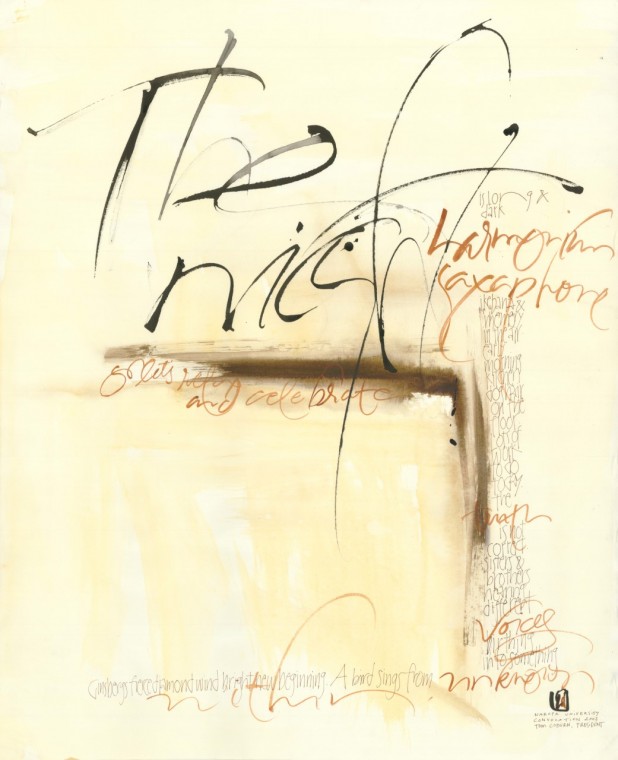 Naropa Convocation, 2003 Performance Art
Naropa Convocation, 2003 Performance Art
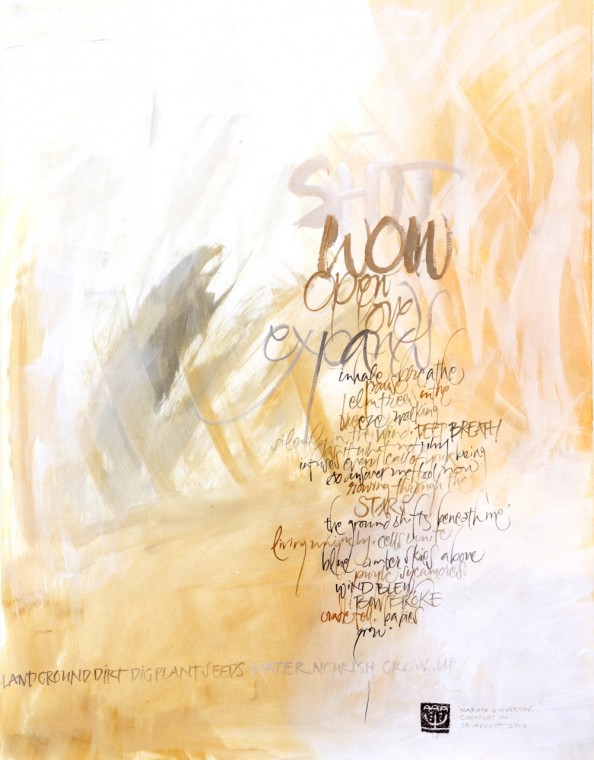 Naropa Convocation, 2010 Performance Art
Naropa Convocation, 2010 Performance Art
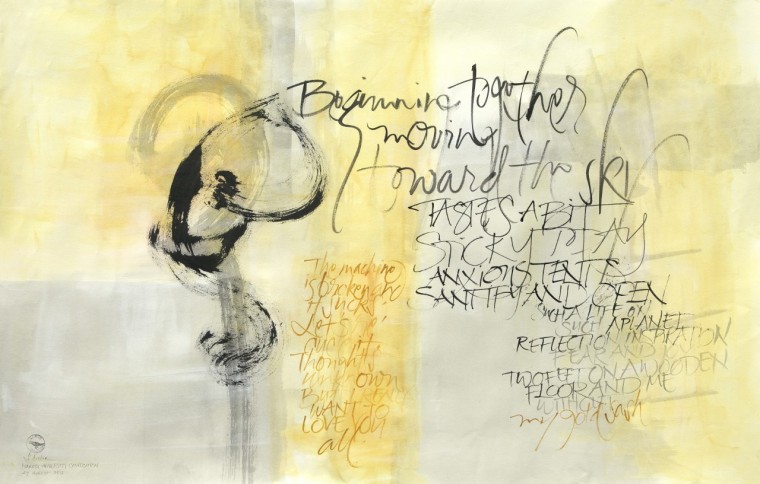 Naropa Convocation, 2012 Performance Art
Naropa Convocation, 2012 Performance Art
TCR: How has COVID-19 and the quarantine affected your life? As we are all dealing with this in a variety of ways of adapting or sheltering in place, what has this looked like for you in Kentucky? Or while visiting your dad and stepmom in Minnesota? Also you’re having to undergo renovation and repairs after a flood in your studio? I remember thinking it remarkable and unexpected when after beginning to correspond with you for this interview your initial response seemed so upbeat and conveyed a general sense of gratitude.
COVID-19 coincides with upheaval in the home: work (exhibits and teaching) has been cancelled, IRS audit, flood in the studio….. but to give this context, we live in the woods in Kentucky, and it has been one of the loveliest springs ever. I hear many people say this— and I sense that the sky and trees are glad. I love being out of doors with the sycamore, tulip poplars, dogwoods, redbuds, oaks, beeches…and this is a corridor for migrating birds. They seem glad too. To be quarantined here in this solitude and quiet has offered the deepest kind of nourishment. The upheaval of reduced income, uncertainty about being able to schedule classes, not being able to work in my studio, reaching for ways to re-imagine my work and income…my 96 year old father facing the death of his wife, and how do I get him safely from Minnesota to California in these times? Especially when his wife’s family does not believe in the danger of COVID-19? The last class I taught was in February in Costa Rica, and this was just after an exhibit that went well. So builders began work on a long needed front deck to replace crumbling concrete. I took on the expense of this, not knowing my 2020 income would vanish. And yet, and yet, all this time for introspection fortifies a growing trust in what is, and what will come…including a new and better studio, expansion of the ways I teach, a sparkling feeling in the house of being made new. And hopes for my father getting to a new home. It has created the opportunity to raise some money for our local family-owned art store, by offering free coloring book pages: https://www.lauriedoctor.com/coloringpages and also, COVID-19 increases awareness for needed social change.
TCR: Can you tell us a little bit about this collection/book of essays you’re working on during the quarantine? Making the most of the time as you can?
I have been writing essays on the creative pattern for a long while, and am following nudges to put them into book form, with illustrations. One of the first ones I have edited is “Finding a place you trust:”
https://www.lauriedoctor.com/musings/2020/5/24/find-a-place-you-trust
I don’t know what the title is yet…a student who is an engineer, when I asked him about what brought him to my class, he answered: I want to think like an artist. This has made me consider think like an artist as a title …..but I am still sorting, editing, writing.
Note: Our interview was cut short after Laurie’s stepmom passed away on June 29th, after a battle with cancer.
You can find out more about Laurie Doctor, subscribe to her newsletter, or contact her at her website: here.
Laurie: We do really appreciate having the opportunity to feature your work for Issue #24 and all your time spent talking with us during these particularly trying times.
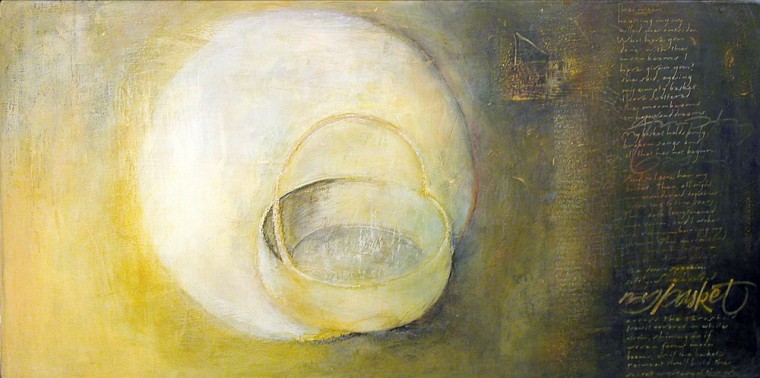 Laurie Doctor, moon and basket
Laurie Doctor, moon and basket

